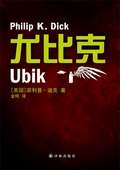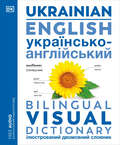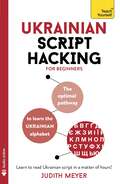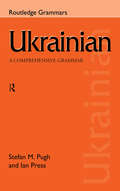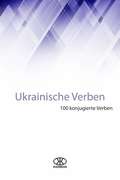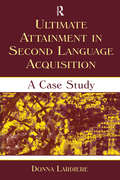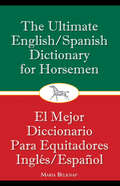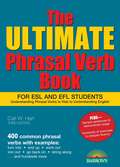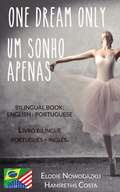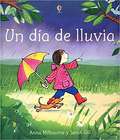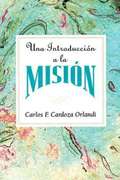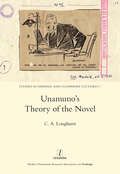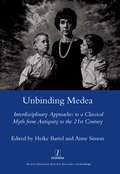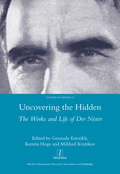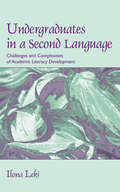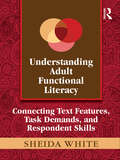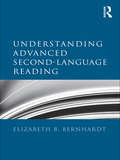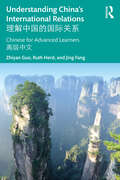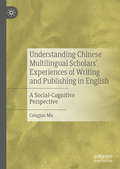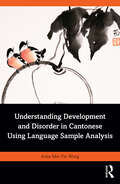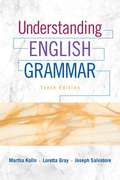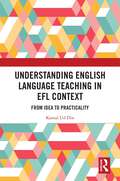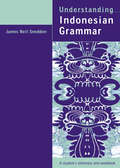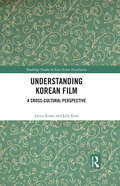- Table View
- List View
Ubik (Mandarin Edition)
by Philip K. DickFrom the stuff of space opera, Dick spins a deeply unsettling existential horror story, a nightmare you'll never be sure you've woken up from. 乔*奇普为格伦*朗西特的反超能咨询公司工作 保护人们免受通灵师和先知的心灵窥探 在一次前往月球执行任务的过程中 朗西特的行动组遭遇埋伏 朗西特身亡 行动组成员迅速将朗西特的遗体送往苏黎世的亡灵馆冰冻冷藏 并试图与他的大脑取得联系 然而 不仅没有成功联系上朗西特 行动组成员还发现 钱币,香烟等物品均在发生退转 时光似乎在往回倒流 究竟发生了什么事 这是一个让人深感不安的生存恐怖故事 一场你不知道自己是否还会醒过来的噩梦
Ukrainian - English Bilingual Visual Dictionary (DK Bilingual Visual Dictionaries)
by DKWith more than 6,750 fully illustrated words and phrases in Ukrainian and English, along with a free bilingual audio app, DK's Ukrainian-English Bilingual Visual Dictionary is your essential companion to learning Ukrainian.You will learn all the words and phrases you need to buy food and clothes, talk about work and education, visit the doctor, go to the bank, use public transportation, and much more. Perfect for students, tourists, and business travelers, the dictionary is incredibly easy to follow, with thematically organized vocabulary so you can find closely related words on a particular topic. Words and phrases are illustrated with full-color photographs and artwork, helping to fix new vocabulary in your mind. The supporting audio app enables you to hear all the words and phrases spoken out loud in both languages to help you learn, remember, and pronounce important vocabulary.
Ukrainian Script Hacking: The optimal pathway to learn the Ukrainian alphabet
by Judith MeyerUsing a unique, tried and tested algorithm, this book teaches you how to quickly and efficiently recognise letters and common words in Ukrainian script. Whether you need to quickly be able to read and understand the words around you, or are preparing to learn Ukrainian and want to master the basics, this is the book for you. In this book you will find: · An introduction to Ukrainian script and the Cyrillic alphabet · Plenty of practice activities to help you recognise each letter of the alphabet · Helpful mnemonics to make you remember the shape of each letter · Accompanying audio files so you know how to pronounce letters and words · Handy tips to help you decipher common and familiar words The audio for this course can be downloaded from the Teach Yourself Library app or streamed at library.teachyourself.com. Rely on Teach Yourself, trusted by language learners for over 85 years.
Ukrainian: A Comprehensive Grammar (Routledge Comprehensive Grammars)
by Ian Press Stefan PughUkrainian: A Comprehensive Grammar is a complete reference guide to modern Ukrainian grammar.The authors have consulted a great number of sources, in addition to a wide range of native speakers. The result is the first true reference grammar of Ukrainian to be published outside Ukraine, it will be the standard reference work for years to come.The volume is organized to enable students of the language to find the information they seek quickly and easily, and to promote a thorough understanding of Ukrainian grammar. It presents the complexities of the language in a systematic and user-friendly form.Features include* detailed tables in each chapter for easy reference* numerous examples throughout* thorough descriptions of all parts of speech* list of grammatical terms in English and Ukrainian* complete descriptions of the word-formational processes of Ukrainian* an overview of past and present changes in the language* bibliography of works relating to Ukrainian* full index.
Ukrainische Verben (100 Veben Serie #15)
by KarbidsSpeziell für elektronische Geräte geschrieben, hat ,Ukrainische Verben' eine Einführung in die Bildung aller Verbalzeiten im Ukrainischen, sowie 100 wesentliche Verben vollständig konjugiert mit ihrer Bedeutung. Dieses Buch ermöglicht es dem Benutzer, im gesamten Text zu suchen, da es keine Bilder oder verschwindenden oder unleserlichen Text hat.
Ultimate Attainment in Second Language Acquisition: A Case Study
by Donna LardiereThe first book-length treatment of its type, Ultimate Attainment in Second Language Acquisition is a case study with a solid theoretical grounding that examines the language of an immigrant learner of English, and thereby presents a much needed understanding of the linguistic competence of second language speakers. Based on longitudinal data collected over a period of 16 years, this clear and accessible presentation is well-grounded in linguistic theory and in second language acquisition research issues. Author Donna Lardiere presents the narrative of Patty, an adult Chinese immigrant learner of English, who achieves native-like proficiency in some areas of her English idiolect, although reaches a plateau in her language acquisition, known as the concept of fossilization. By addressing this concept, a central idea in second language acquisition research, Lardiere fills a void in existing literature. Individual chapters focus on Patty’s end state knowledge of grammatical areas of finiteness, past-tense marking, word order, wh-movement and relativization, passivization, number marking, and use of determiners. Important topics discussed throughout the book include:*learner variability in production;*case study methodology;*the roles of motivation and prior language (L1) knowledge; and*sensitivity to input in circumscribing ultimate attainment in adult second language acquisition. Ultimate Attainment in Second Language Acquisition is intended for anyone whose research is in the areas of second language acquisition, language acquisition, theoretical, applied, or developmental linguistics. It is also appropriate for graduate level students of TESOL and teachers who work with more advanced learners of foreign languages.
Ultimate English/Spanish Dictionary for Horsemen
by Maria BelknapWritten specifically for horse people, this book covers topics and words that regular English/Spanish dictionaries might not, including horse health care, feeding, grooming, tack and equipment, and breeding terms. With more than 10,000 typically grouped word and phrase entries commonly used in the horse industry, regional variations, and a pronunciation guide.
Ultimate Phrasal Verb Book, 3rd edition: For Esl And Efl Students
by Carl W. HartUpdated to reflect questions found on the most recent ESL tests, this book presents 400 common phrasal verbs as they are used in everyday English. Phrasal verbs are verbs combined with prepositions or adverbs. Familiarity with phrasal verbs and understanding their use as nouns (breakup, showoff, etc.) or adjectives (spaced-out, broken-down, stressed-out, and many others) is essential to ESL students. Updated information includes: the most commonly used phrasal verbs; activities and examples that reflect our current technology and the world around us; an expanded introduction for the teacher with a thorough breakdown and explanation of phrasal verbs; and, a discussion of separable and inseparable phrasal verbs in Unit I, and more. This book’s hundreds of examples in context and hundreds of exercises will be extremely useful to ESL students who are preparing for TOEFL or who simply wish to improve their English.
Um Sonho Apenas/One Dream Only (Livro bilíngue: Português - Inglês)
by Elodie Nowodazkij Hamíreths CostaEstá aprendendo inglês? Are you learning Portuguese? This book can help you with that: one page in English, one page in Portuguese... Este livro pode te ajudar: uma página em inglês e outra em português... She thought she was on her way to the top... Sixteen-year-old Natalya Pushkaya has one dream and one dream only: becoming the best ballerina ever.Dancing's always been who she is and she's working her hardest to land the main role of the School of Performing Arts' end-of-the-year showcase. But...will she make it? Within a week, Natalya's life will be changed forever. ------------------------------------- Ela achava que estava a caminho do topo... Natalya Pushkaya de 17 anos tem um sonho apenas: se tornar a melhor bailarina do mundo. Dançar sempre foi o que ela é e ela está trabalhando duro para conseguir o papel principal no show de final de ano da Escola de Artes Cênicas. Mas ela vai conseguir? Em uma semana a vida de Natalya vai mudar para sempre.
Una introducción a la misión AETH: An Introduction to Missions Spanish
by Carlos F. Cardoza-Orlandi"La iglesia existe por la misión, al igual que el fuego existe por la combustión". Con estas palabras de Emil Brunner, el autor nos recuerda que ser la iglesia es estar en misión. Después de describir las diferentes cautividades de la misión, que han subyugado al cristianismo de los Estados Unidos, el autor lucha para exponer una fuerte y comprometida practica de la misión, comenzando en las congregaciones locales y extendiéndose hasta la comunidad más amplia.Este libro de Introducción a la Misión, puede ayudar a estudiantes de seminario, y a grupos de estudio de laicos, a conocer el mandato cristiano fundamental y unirse a la misión de Dios en el mundo."The church exists by mission as fire exists by burning." With these words of Emil Brunner, the author reminds us to be the church, is to be in mission. After describing the various captivities of the mission, which subjugated to Christianity in the United States, the author struggles to expose a strong and committed practice of mission, beginning in local congregations and extending to the broader community. This book Una Introduccion a la Mision can help seminary students and lay study groups to learn the fundamental Christian mandate and join God's mission in the world.
Unamuno's Theory of the Novel
by C.A. LonghurstMiguel de Unamuno (1864-1936) is widely regarded as Spain's greatest and most controversial writer of the first half of the twentieth century. Professor of Greek, and later Rector, at the University of Salamanca, and a figure with a noted public profile in his day, he wrote a large number of philosophical, political and philological essays, as well as poems, plays and short stories, but it is his highly idiosyncratic novels, for which he coined the word nivola, that have attracted the greatest critical attention. Niebla (Mist, 1914) has become one of the most studied works of Spanish literature, such is the enduring fascination which it has provoked. In this study, C. A. Longhurst, a distinguished Unamuno scholar, sets out to show that behind Unamuno's fictional experiments there lies a coherent and quasi-philosophical concept of the novelesque genre and indeed of writing itself. Ideas about freedom, identity, finality, mutuality and community are closely intertwined with ideas on writing and reading and give rise to a new and highly personal way of conceiving fiction.
Unbinding Medea
by Heike BartelMedea - simply to mention her name conjures up echoes and cross-connections from Antiquity to the present. The vengeful wife, the murderess of her own children, the frail, suicidal heroine, the archetypal Bad Mother, the smitten maiden, the barbarian, the sorceress, the abused victim, the case study for a pathology. For more than two thousand years, she has arrested the eye in paintings, reverberated in opera, called to us from the stage. She demands the most interdisciplinary of study, from ancient art to contemporary law and medicine; she is no more to be bound by any single field of study than by any single take on her character. The contributors to this wide-ranging volume are Brian Arkins, Angela J. Burns, Anthony Bushell, Richard Buxton, Peter A. Campbell, Margherita Carucci, Daniela Cavallaro, Robert Cowan, Hilary Emmett, Edith Hall, Laurence D. Hurst, Ekaterini Kepetzis, Ivar Kvistad, Catherine Leglu, Yixu Lue, Edward Phillips, Elizabeth Prettejohn, Paula Straile-Costa, John Thorburn, Isabelle Torrance, Terence Stephenson, and Amy Wygant.
Uncovering the Hidden: The Works and Life of Der Nister
by Gennady EstraikhDer Nister (Pinkhes Kahanovitsh, 1884-1950) is widely regarded as the most enigmatic author in modern Yiddish literature. His pseudonym, which translates as 'The Hidden One', is as puzzling as his diverse body of works, which range from mystical symbolist poetry and dark expressionist tales to realist historical epic. Although part of the Kiev Group of Yiddish writers, which also included David Bergelson and Peretz Markish, Der Nister remained at the margins of the Yiddish literary world throughout his life, mainstream success eluding him both in- and outside the Soviet Union. Yet, to judge from the quantity of recent research and translation work, der Nister is today one of the best remembered Yiddish modernists. The present collection of twelve original articles by international scholars re-examines Der Nister's cultural and literary legacy, bringing to light new aspects of his life and creative output.
Undergraduates in a Second Language: Challenges and Complexities of Academic Literacy Development
by Ilona LekiThis is the first book-length study of bilingual, international, and immigrant students in English writing courses that attempts to fully embed their writing experiences within the broader frame of their personal histories, the human context of their development, and the disciplinary contexts of their majors. It addresses the questions: How useful are L2 writing courses for the students who are required to take them? What do the students carry with them from these courses to their other disciplinary courses across the curriculum? What happens to these students after they leave ESL, English, or writing classes? Drawing on data from a 5-year longitudinal study of four university students for whom English was not their strongest/primary language, it captures their literacy experiences throughout their undergraduate careers. The intensive case studies answer some questions and raise others about these students’ academic development as it entwined with their social experiences and identity formation and with the ideological context of studying at a US university in the 1990s.
Understanding Adult Functional Literacy: Connecting Text Features, Task Demands, and Respondent Skills
by Sheida White"This is a genuinely scholarly work ... It is based on [analysis of] the most up-to-date quantitative surveys that we have on adult literacy. These surveys are the gold standard in terms of documenting adult literacy in the United States ...The author analyzes these extensive surveys and puts them into a theoretical context in a way that has not been done before." – Rosemary J. Park, University of Minnesota "I don’t know of any book providing the same information. There is a shortage of literature in this area and the book is an excellent contribution." – Dolores Perin, Teachers College, Columbia University "The contribution of the theory is important – not only to adult literacy but to our understanding of the reading process at nearly every level ... Additionally, the application of multidimensional item response modeling to the new TTR theory offers a tantalizing view of how the predictive validity of a theory might be tested and used to provide practical results." – Larry Mikulecky, Indiana University Very often, individual differences in literacy performance are understood exclusively in terms of the characteristics of the reader. Drawing on a rich array of empirical research, the author presents a detailed and highly integrative new theory of functional literacy. The text-task-respondent (TTR) theory of functional literacy offers improved understanding of how successful performance on everyday literacy tasks involves a dynamic relationship among the text, the task, and the reader. This book will appeal primarily to assessment developers who wish to select tasks and texts of varying difficulty to yield more precise estimates of adult literacy; to researchers who study cognitive, linguistic, and discourse processes; and to teachers who want to find new ways to increase text comprehension among students, including English language learners and struggling readers. The text is appropriate for an advanced course in adult education, discourse analysis, educational measurement, educational psychology, literacy, or linguistics – or as a reference work for those interested in literacy.
Understanding Advanced Second-Language Reading
by Elizabeth B. BernhardtWhat distinguishes this book is its broad, yet thorough, view of theory, process, and research on adult second-language reading. Offering extensive discussions of upper-register second-language texts (both expository and narrative) that adult second-language readers encounter daily across the globe, it also presents an assessment schema for second-language text comprehension as well as for the assessment of teaching. Understanding Advanced Second-Language Reading: includes languages other than English in the discussion of second language reading is firmly anchored in a theory of second language reading ─ the concept of compensatory processing emphasizes the multi-dimensionality and dynamic nature of L2 reading development focuses on comprehension of upper-register literary texts balances theory and instructional practices. Filling the need for a coherent, theoretically consistent, and research-based portrait of how literate adolescents and adults comprehend, and learn to comprehend, at greater levels of sophistication and whether that ability can be enhanced by instruction, this is a must-have resource for reading and second-language researchers, students, and teachers.
Understanding China's International Relations 理解中国的国际关系: Chinese for Advanced Learners 高级中文
by Zhiyan Guo Jing Fang Ruth HerdChina’s influence on the international stage has grown significantly over recent decades. Alongside the rapid development of its economy, the country has come to play a key role within the global configuration of politics and diplomacy. It has therefore become vital that students of Chinese acquire advanced language skills. This book familiarises students with the use of the formal register, allowing them to extend their proficiency to the advanced level in the skills of reading, writing, speaking, and listening. In this way, students may also increase their understanding of China’s cultural heritage, politics, and international relations.The texts chosen are written in a variety of styles and employ various forms of Chinese discourse in order that students may achieve greater breadth and depth in their knowledge of grammar and syntax. Moreover, students will find that there is ample opportunity to develop the tools with which to express opinions appropriately, both orally and in writing. The selection of materials in the book has been based on the CEFR (Common European Framework for Reference) B2 and above, the Advanced level of ACTFL (American Council on the Teaching of Foreign Languages), and Grades 5 (HSK 5) and above of the newly-published version of the Chinese Proficiency Grading Standards for International Chinese Language Education. Full audio is available online.
Understanding Chinese Multilingual Scholars’ Experiences of Writing and Publishing in English: A Social-Cognitive Perspective
by Congjun MuThis book analyses the English writing and publishing experiences of 118 scholars from 18 Chinese universities from a social-cognitive perspective. It addresses the challenges and strategies multilingual scholars, particularly Chinese academics, reported in the process of writing and publishing in English. This allows the author to present a taxonomy of journal article writing strategies that correspond to the lived experiences of scholars in China, but which can also be applied to other contexts in the world. This book offers a step-by-step analysis of ethnographic case studies, insights and implications for teaching practice, as well as suggested directions for future research. It will be of particular interest to scholars in the fields of ERPP (English for Research Publication Purposes) as well as students and scholars of applied linguistics more broadly.
Understanding Development and Disorder in Cantonese using Language Sample Analysis
by Anita Mei-Yin WongUnderstanding Development and Disorder in Cantonese using Language Sample Analysis brings together 20 years of research on typical development and Development Language Disorder (DLD) in Cantonese. This book begins with a succinct overview of Cantonese, which is a popular variety of Chinese, a Sino-Tibetan language. The second chapter describes a new framework of the Grammatical Analysis of Cantonese Samples (GACS), which is developed on the basis of functionalist and usage-based theories of language and language development. The third chapter reports on a quantitative analysis, as well as a qualitative description of the development of Cantonese in preschool children using the GACS framework. The book ends with a chapter that presents the linguistic profile of a Cantonese-speaking child with DLD. It also illustrates how to make decisions on intervention targets on the basis of the grammatical and error analysis. The book provides a timely and important addition to the typological diversity of studies in both child language development and disorder. This book is informative for students and practitioners of speech and language therapy, students in early childhood education and Chinese linguistics, and researchers in child language development and disorders.
Understanding English Grammar: Tenth Edition
by Loretta Gray Robert W. Funk Joseph Salvatore Martha J. KollnThe essentials of English grammar, with a distinctively clear organization and user-friendly language. The acclaimed Understanding English Grammar fosters students’ innate language expertise as they study sentence grammar. It offers a practical blend of the most useful elements of both traditional and new linguistic grammar, beginning with an overview of English as a world language, language change, and various classroom issues associated with prescriptive grammar and correctness, along with an updated list of further readings. Every discussion is viewed through the eyes of a novice reader, bearing in mind how the current generation of students uses communication tools for social purposes. Both students and teachers appreciate the self-teaching quality that incremental exercises provide throughout the chapters, with answers at the end of the book. The Tenth Edition introduces new coauthors Loretta Gray and Joseph Salvatore—two respected scholars who bring their special expertise in linguistics and creative writing, as well as long experience in teaching grammar and writing.
Understanding English Language Teaching in EFL Context: From Idea to Practicality
by Kamal Ud DinThis volume is comprehensively designed to help prospective English Language Teaching (EFL) teachers specializing in EFL mainly in South Asian countries. It analyses the application of ELT theories, concepts, and methods to sharpen their understanding of the various techniques used for teaching English effectively in the EFL context. The book discusses the basic concepts of language aimed to develop a sense of the language phenomenon as a unique human attribute. It covers the theories of language from various disciplines such as biology, sociology, psychology, and linguistics. The book explains the underlying structures or components that shape the edifice of languages such as phonology, morphology, syntax, grammar, phonetics, semantics, and pragmatics. While taking the reader through language learning theories with a focus on English as the second language, it discusses the different teaching methods that can be adopted by teachers in classroom settings. The book will be of interest to teachers, students and researchers of education, teacher education, and English Language Teaching. It will also be useful for educators, English language teachers, language learners, professionals working in the field of education and language, and those who aspire to teach and learn English in Foreign context.
Understanding Indonesian Grammar: A student's reference and workbook
by James Neil SneddonUnderstanding Indonesian Grammar is a reference and workbook designed primarily for intermediate and advanced students in senior years of high school and at university. It provides a clear, non-technical description of the important structures in the language, together with practical exercises. It can be used with any Indonesian language course. * Units are largely self-contained, enabling teachers to select topics in any order, depending on the structure of their course and the needs of their students.* The various aspects of each topic are discussed one at a time and tested in exercises so that the learner is guided step by step to an in-depth understanding of the topic.* Contains descriptions of many frequently occurring affixes and structures which are not dealt with in existing course materials. * Clear explanations and answers to all exercises enable learners to use the book without a teacher.* Notes throughout the book provide additional information on unusual or irregular features of grammar. * All grammatical terms used are defined in an extensive glossary.The comprehensiveness and flexibility of Understanding Indonesian Grammar make it an indispensable resource for students and teachers of Indonesian.James Neil Sneddon PhD is an associate professor in the School of Languages at Griffith University, with long experience teaching Indonesian language and linguistics. He is the author of Indonesian Reference Grammar (1996).
Understanding Korean Film: A Cross-Cultural Perspective
by Jieun Kiaer Loli KimFilm viewing presents a unique situation in which the film viewer is unwittingly placed in the role of a multimodal translator, finding themselves entirely responsible for interpreting multifaceted meanings at the mercy of their own semiotic repertoire. Yet, researchers have made little attempt, as they have for literary texts, to explain the gap in translation when it comes to multimodality. It is no wonder then that, in an era of informed consumerism, film viewers have been trying to develop their own toolboxes for the tasks that they are faced with when viewing foreign language films by sharing information online. This is particularly the case with South Korean film, which has drawn the interest of foreign viewers who want to understand these untranslatable meanings and even go as far as learning the Korean language to do so. Understanding Korean Film: A Cross-Cultural Perspective breaks this long-awaited ground by explaining the meaning potential of a selection of common Korean verbal and non-verbal expressions in a range of contexts in South Korean film that are often untranslatable for English-speaking Western viewers. Through the selection of expressions provided in the text, readers become familiar with a system that can be extended more generally to understanding expressions in South Korean films. Formal analyses are presented in the form of in-depth discursive deconstructions of verbal and non-verbal expressions within the context of South Korea’s Confucian traditions. Our case studies thus illustrate, in a more systematic way, how various meaning potentials can be inferred in particular narrative contexts.
Understanding Korean Film: A Cross-Cultural Perspective (Routledge Studies in East Asian Translation)
by Jieun Kiaer Loli KimFilm viewing presents a unique situation in which the film viewer is unwittingly placed in the role of a multimodal translator, finding themselves entirely responsible for interpreting multifaceted meanings at the mercy of their own semiotic repertoire. Yet, researchers have made little attempt, as they have for literary texts, to explain the gap in translation when it comes to multimodality. It is no wonder then that, in an era of informed consumerism, film viewers have been trying to develop their own toolboxes for the tasks that they are faced with when viewing foreign language films by sharing information online. This is particularly the case with South Korean film, which has drawn the interest of foreign viewers who want to understand these untranslatable meanings and even go as far as learning the Korean language to do so. Understanding Korean Film: A Cross-Cultural Perspective breaks this long-awaited ground by explaining the meaning potential of a selection of common Korean verbal and non-verbal expressions in a range of contexts in South Korean film that are often untranslatable for English-speaking Western viewers. Through the selection of expressions provided in the text, readers become familiar with a system that can be extended more generally to understanding expressions in South Korean films. Formal analyses are presented in the form of in-depth discursive deconstructions of verbal and non-verbal expressions within the context of South Korea’s Confucian traditions. Our case studies thus illustrate, in a more systematic way, how various meaning potentials can be inferred in particular narrative contexts.
